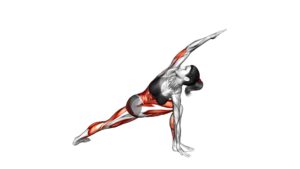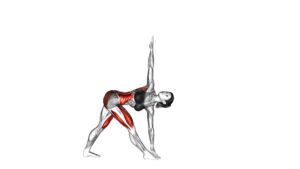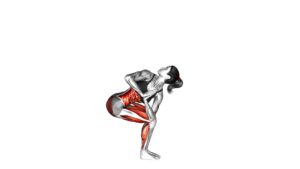Revolved Head to Knee Pose (female) – Video Exercise Guide & Tips

Are you looking to improve your flexibility and strengthen your core?
Watch This Exercise Video
Look no further than the Revolved Head to Knee Pose.
In this video exercise guide, you'll find step-by-step instructions and helpful tips to perfect your form.
Whether you're a beginner or an experienced yogi, this pose offers numerous benefits for your body and mind.
Grab your mat and get ready to take your practice to the next level.
Let's dive in!
Key Takeaways
- Revolved Head to Knee Pose improves digestion and relieves constipation by stimulating abdominal organs.
- The pose increases flexibility in hamstrings, hips, and lower back, enhancing overall flexibility and range of motion.
- Prior to performing the pose, it is important to warm up the body with stretches for hamstrings and hips, as well as perform gentle exercises like sun salutations or dynamic stretches.
- Modifications and variations of the pose can be used to deepen the practice, such as using a strap to reach the foot, binding the hands behind the back to deepen the twist, or lifting the back leg off the mat for an advanced variation.
Benefits of Revolved Head to Knee Pose
You will frequently experience numerous benefits by practicing Revolved Head to Knee Pose. This pose, also known as Parivrtta Janu Sirsasana, is a powerful yoga posture that can have a positive impact on your body and mind.
One of the key benefits of this pose is its ability to improve digestion. As you twist your torso and bring your head towards your knee, you stimulate the abdominal organs, helping to improve digestion and relieve constipation. The twisting motion also helps to massage the internal organs, promoting detoxification and a healthy digestive system.
Additionally, practicing Revolved Head to Knee Pose can help increase flexibility. This pose stretches the hamstrings, hips, and lower back, improving overall flexibility and range of motion. By regularly practicing this pose, you can enhance your ability to move freely and with ease.
Now that you understand the benefits of Revolved Head to Knee Pose, let's move on to how to prepare for this pose.
Preparing for the Pose
To prepare for Revolved Head to Knee Pose, it's important to focus on warming up your body and creating a stable foundation. This will help you perform the pose more effectively and reduce the risk of injury.
Before attempting the pose, start with some preparatory stretches to loosen up your hamstrings and hips. Try standing forward folds or seated forward bends to gradually open up these areas.
Additionally, warming up the body with some gentle exercises like sun salutations or dynamic stretches can help increase blood flow and flexibility. These movements will prepare your muscles and joints for the pose and make it easier to achieve the desired position.
Remember to listen to your body and move slowly and mindfully during the warm-up process. By properly preparing your body and warming up, you'll enhance your overall practice and maximize the benefits of Revolved Head to Knee Pose.
Step-by-Step Guide to the Pose
To perform Revolved Head to Knee Pose effectively and safely, focus on creating a stable foundation and warming up your body. Here is a step-by-step guide to help you achieve the pose:
- Start by sitting on the floor with your legs extended in front of you.
- Bend your right knee and place the sole of your right foot against your left inner thigh.
- Inhale deeply and lengthen your spine, reaching your arms overhead.
- Exhale as you twist your torso to the left, bringing your left hand to the outside of your right foot.
- As you twist, keep your spine long and your shoulders relaxed.
- To deepen the stretch, you can gently press your right knee down with your right hand.
- Remember to breathe deeply and evenly throughout the pose. Inhale to lengthen your spine and exhale to deepen the twist.
- Common mistakes to avoid include rounding the spine, forcing the twist, and holding your breath.
- As with any yoga pose, listen to your body and modify the pose as needed to ensure comfort and safety.
Modifications and Variations
What are some ways to modify and vary the Revolved Head to Knee Pose?
If you're looking to modify this pose, you can use a strap to help you reach your foot if you can't quite reach it yet. Simply loop the strap around your foot and hold onto the ends to gently pull yourself forward. This modification allows you to still get the benefits of the pose without straining or overstretching.
For those looking for more advanced variations, you can try binding your hands behind your back while in the pose. Start by reaching your top arm behind your back and your bottom arm underneath your leg. Try to clasp your hands together, but if you can't reach, you can use a strap to bridge the gap. This variation helps to deepen the twist and open up the shoulders.
Another advanced variation is to lift your back leg off the mat and extend it straight out in front of you. This variation requires a lot of core strength and flexibility, so make sure you're warmed up and ready before attempting it.
Remember to always listen to your body and modify or vary the pose as needed. Enjoy exploring the modifications and advanced variations of the Revolved Head to Knee Pose!
Tips for Deepening Your Practice
Explore various techniques to enhance your practice of the Revolved Head to Knee Pose. Here are some tips to deepen your practice and increase flexibility:
- Use props: Place a folded blanket or bolster under your hip if you can't reach the floor. This will help you find stability and maintain proper alignment.
- Focus on your breath: Pay attention to your breath throughout the pose. Inhale deeply to create space in your body, and exhale to deepen the twist. This will help you relax and go deeper into the pose.
- Engage your core: Activate your core muscles by drawing your navel towards your spine. This will provide stability and support as you twist.
- Start with modifications: If you're a beginner, start with modified versions of the pose. Use a strap around your foot to help you reach your extended leg, or bend your knee slightly if your hamstrings are tight.
- Practice regularly: Consistency is key when it comes to deepening your practice. Set aside time each day to work on the pose, even if it's just for a few minutes. Over time, you'll notice improvements in your flexibility and strength.
Frequently Asked Questions
Can Revolved Head to Knee Pose Help With Digestion and Bloating?
Revolved Head to Knee Pose can be beneficial for digestion and bloating. This yoga pose involves twisting the torso, which stimulates the digestive system and can help relieve bloating.
By compressing the abdomen and massaging the internal organs, this pose can improve digestion and promote a healthy gut.
What Are Some Common Mistakes to Avoid While Practicing Revolved Head to Knee Pose?
When practicing Revolved Head to Knee Pose, it's important to be mindful of common mistakes that can affect your alignment and overall experience.
One common mistake is rounding your back instead of keeping it straight. Remember to engage your core and lengthen your spine.
Another mistake is forcing yourself into the pose and compromising your flexibility. Take it slow and listen to your body's limits.
Is It Necessary to Be Flexible in Order to Practice This Pose?
It's not necessary to be super flexible to practice Revolved Head to Knee Pose. The pose focuses more on alignment and proper form rather than extreme flexibility.
When practicing, make sure you align your body correctly and maintain a straight spine. If you're a beginner, you can use modifications such as using a strap or bending your knee slightly.
Can Revolved Head to Knee Pose Help Relieve Lower Back Pain?
Revolved Head to Knee Pose can be beneficial for relieving lower back pain. By twisting the spine and stretching the hamstrings, it helps to release tension in the back muscles.
Variations of this pose, such as using a strap or block for support, can be helpful for those with limited flexibility. Modifications for Revolved Head to Knee Pose can be made by bending the knee or placing a folded blanket under the hip.
Remember to listen to your body and practice with proper alignment to avoid strain.
How Long Should I Hold Revolved Head to Knee Pose to Experience Its Benefits?
To experience the benefits of Revolved Head to Knee Pose, hold it for at least 30 seconds on each side. This will allow your body to stretch and strengthen the muscles in your back, hips, and legs.
If you're a beginner, you can modify the pose by using a strap to hold onto your foot.
For advanced practitioners, you can explore variations like binding your hands or extending your top arm overhead.
Conclusion
In conclusion, the revolved head to knee pose is a beneficial yoga pose that helps stretch and strengthen the body.
By following the step-by-step guide and making modifications if needed, you can safely practice this pose.
Remember to listen to your body and go at your own pace, gradually deepening your practice over time.
With consistent practice, you can experience the numerous benefits of the revolved head to knee pose.

Author
Years ago, the spark of my life’s passion ignited in my mind the moment I stepped into the local gym for the first time. The inaugural bead of perspiration, the initial endeavor, the very first surge of endorphins, and a sense of pride that washed over me post-workout marked the beginning of my deep-seated interest in strength sports, fitness, and sports nutrition. This very curiosity blossomed rapidly into a profound fascination, propelling me to earn a Master’s degree in Physical Education from the Academy of Physical Education in Krakow, followed by a Sports Manager diploma from the Jagiellonian University. My journey of growth led me to gain more specialized qualifications, such as being a certified personal trainer with a focus on sports dietetics, a lifeguard, and an instructor for wellness and corrective gymnastics. Theoretical knowledge paired seamlessly with practical experience, reinforcing my belief that the transformation of individuals under my guidance was also a reflection of my personal growth. This belief holds true even today. Each day, I strive to push the boundaries and explore new realms. These realms gently elevate me to greater heights. The unique combination of passion for my field and the continuous quest for growth fuels my drive to break new ground.







